Growing and caring for pumpkins in the garden

The title of the largest vegetable in our gardens undoubtedly belongs to pumpkin. In hot climates, for example in Central Asia, specimens were grown that reached 200 kilograms. In a temperate climate, with proper care, it is possible to grow a vegetable weighing up to 50 kg.
Content:
- Useful qualities of pumpkin
- Growing pumpkin
- Basic principles of pumpkin care
- The need and features of watering
- Main types of pumpkin fertilizer
Useful qualities of pumpkin
Pumpkin is one of the most healthy vegetables, rich in carotene. The pumpkin diet is prescribed to patients who suffer from various visual impairments.
Nutritionists practice eating pumpkin for patients with stomach diseases and intestinal problems. Pumpkin juice relieves constipation, and the seeds have anthelmintic properties.
Cooks use pumpkin in all sorts of ways to prepare hundreds of varieties of tasty and healthy dishes.
Growing pumpkin
Pumpkin is a heat-loving plant. The most optimal planting time is when the soil has completely warmed up and exceeds the average daily temperature of +10C. Planting a pumpkin into the ground is carried out at a temperature not lower than +13C, since at lower temperatures the seeds do not develop and rot in the soil.
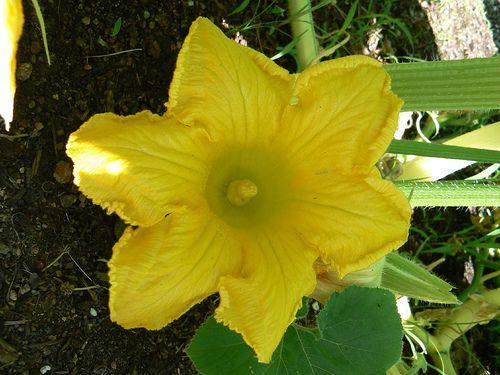
As a rule, at this moment the soil is already deprived of the volume of moisture that would be sufficient for the formation of seedlings. To replenish it, about two liters of warm water at least +50C are poured into the planting hole.As water is absorbed into the soil, seeds are planted. The seeds are covered with a nutrient mixture on top and mulched with peat chips or humus. These activities help to increase the field germination of seeds.
The distance between holes should be at least 60 cm, since the pumpkin has the ability to grow very much. Due to the climbing characteristics, pumpkins are planted away from upright plants, and the beds are planned in open areas with direct access to sunlight.
For rapid seed germination, the entire sowing area is covered with a film, the edges of which are tightly fixed. When shoots appear, the film is cut, a wire frame is installed over the holes and the film is pulled. Many people leave a film on the surface of the soil, using it as mulch, thereby facilitating the process of weed control.
Pumpkin cultivation is done in two ways:
- Seedlings grown in a greenhouse or at home using paper cups a month before the planned planting. The seedlings do not dive.
- Seeds that are applied directly to the soil no later than the end of May.
Basic principles of pumpkin care
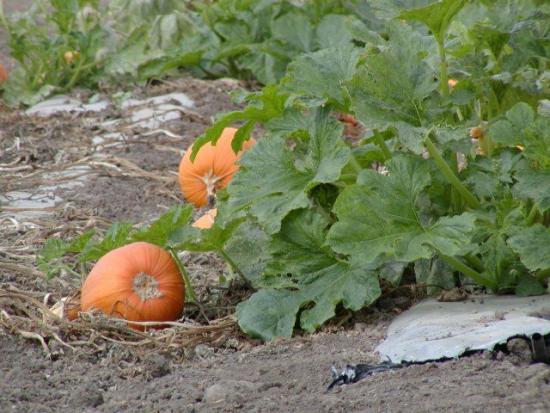
- When sowing, it is mandatory to add organic fertilizers to the holes: manure, peat or humus;
- Covering crops with film to restore temperature conditions;
- Mandatory watering with warm water at the time of flowering, formation and formation of ovaries;
- When the pumpkin ripens, watering is limited;
- Mandatory fertilizing every two weeks;
- Carrying out work to limit the contact of the ripening fruit with the ground by placing non-rotting materials under the vegetable.
The need and features of watering
Being a moisture-loving plant, as evidenced by its overgrown root system and large leaves, pumpkin needs large volumes of watering. Sucking moisture from the soil, it immediately evaporates it through the leaves, thereby providing itself with comfortable greenhouse conditions in the system of its own bush. This is necessary for the plant to form female inflorescences. Being an infinitely delicate flower, these inflorescences do not tolerate heat and dryness. Therefore, special attention should be paid to watering during the pumpkin flowering period.
Water used for irrigation, should not be below +20C. Do not water the pumpkin with water from springs or an artesian well, as cold water can destroy the plant. Before watering, it is necessary to loosen the soil to a depth of 10-12 cm, without damaging the upper part of the root system, and also remove weeds.
Main types of pumpkin fertilizer
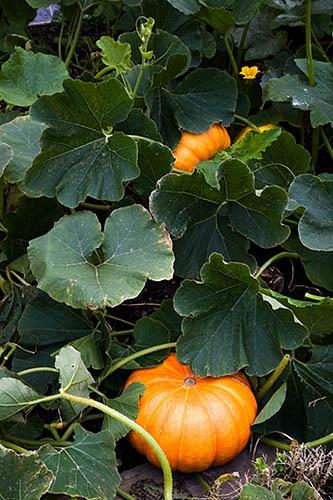
Feeding is carried out in two stages:
- The first stage is carried out when three or five true leaves appear. Nitrophoska is added to the soil in an amount of 10 grams per bush in dry form.
- The second stage is carried out at the very beginning of the formation of lashes with the addition of nitrophoska dissolved in water in an amount of 15 grams per plant bush.
Have a great effect:
- fertilizing with ash and ash elements at the rate of 1 cup per bush;
- fertilizing with mullein solution at a rate of 1:8. Apply one bucket per 5-6 bushes at the beginning of the growing season and one bucket per 3 plants during the period of fruit ripening.
So. To grow a high-quality pumpkin crop in your own garden, a necessary and sufficient condition will be thorough watering and timely fertilizing of plants. The pumpkin growing season lasts about three months.In 90 days, without much effort or labor-intensive operations, you can grow a tasty and healthy product on your plot.
Pumpkin is not a picky plant. With proper care, it will always reward you with a bountiful harvest.

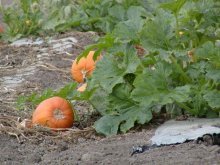
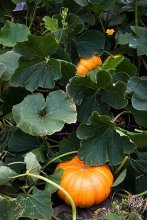



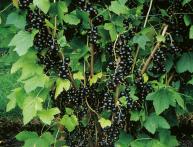
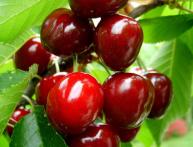

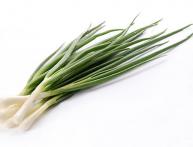
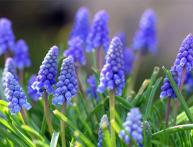
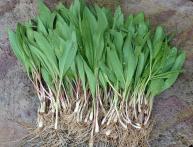
Comments
Pumpkin is a frequent guest in our garden. We plant with seeds, it does not require special care. The main thing is not to delay planting, otherwise the pumpkin may not have time to ripen.
In our family, too, everyone respects pumpkin. Just like you, Elizaveta, we plant it with seeds. And we plant it along the potato field, which is located 2 meters from the lake, so there are no problems with watering))))
Although pumpkin is not an essential vegetable, we plant it every year. The plant is not whimsical and does not require special care. We grind it, put it in bags and freeze it. And then in winter I make amazing porridge with pumpkin. My family likes it. Tasty and healthy. Yes, and pumpkin seeds are a health pantry!
Although pumpkin is not an essential vegetable, we plant it every year. The plant is not whimsical and does not require special care. We grind it, put it in bags and freeze it. And then in winter I make amazing porridge with pumpkin. My family likes it. Tasty and healthy. Yes, and pumpkin seeds are a health pantry!
I like pumpkin for several reasons. Huge orange balls delight the eye in autumn. The decorative effect is amazing. I try to plant a pumpkin in a grassy area and then its huge leaves grow and prevent weeds from growing. And of course, pumpkin has tasty and large seeds.
I eat pumpkin porridge with pleasure with my children, and I grow pumpkins for this at my dacha.It is unpretentious in growth and care, and always produces a good harvest, the main thing is that there is regular watering.
I remembered the poem: “Oh, are all the relatives of the garbuz healthy and alive?”, where the pumpkin is given an honorable place as the head of the garden. Pumpkin is an unpretentious plant, and we usually plant it with potatoes.